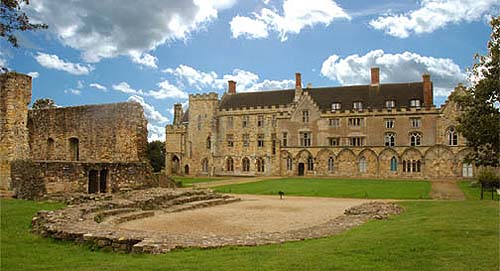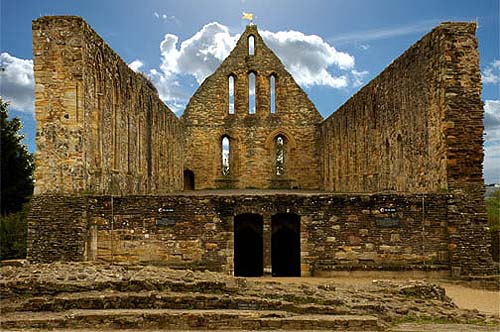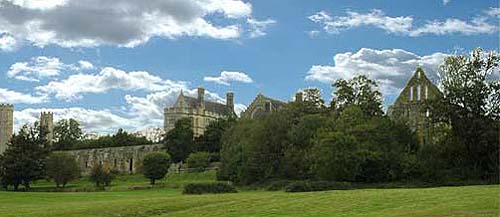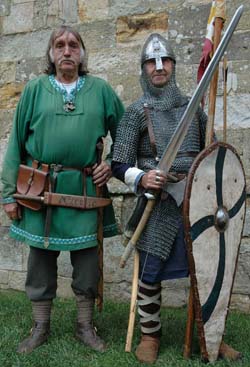Hastings: Two Kings, One Battle, and an Abbey
by Sue Kendrick
Choose carefully your time to visit Senlac Hill. Go at the
week's end when Aefric the Saxon is on hand to regale you with
the dark deeds of the Norman and you will shiver at his tales of
blood and ruthless treachery. His mind is as keen as the blade
he carries, wrought over with runic battle spells and coming to
his hand as easily as a hawk to the falconer. But that is not
the time to go.

Go then when all the men of the re-enactment societies come
together on Senlac Hill to argue Harold's right to the English
throne or uphold William the Bastard's claim of an old king's
dying behest. Go then and you will thrill to the ringing clash
of the Saxon shield wall, the soft hiss of Norman arrows and the
thunder of hooves beating the song of Harold's death knell on
Senlac's bloodied turf. Though your heart will drum and your
blood rise as these modern parodies re-enact the ancient curve in
England's history when all yielded to Norman thrall, that is not
the time to go.
That time is when the days grow short and a keen wind drives
scudding clouds across huge Sussex skies. When fitful sunlight
chases darkling shadows over the bitter turf and softly scattered
rain keeps other visitors to the confines of the Battle Abbey
that now tops this lonely ridge. You alone are left in preferred
seclusion, to hear the whispered echoes of forgotten heroes,
whose bloodied stories of desperate endeavour are forever buried
in Senlac field.
Senlac ridge straddles the road that runs six miles through the
weald to the coastal town of Hastings. It is a sombre place even
on the sunniest of days and rightly so. Even now, so many years
later, the atmosphere is unmistakably portentous. Silent, but
not empty. It's as if the ghosts of those that died here linger
yet, waiting the chance for the real truth of their tale to be
told. And what a tale that is.
It begins in its ending with the Abbey that lords over Senlac
hill. It was built by the Conqueror on the orders of the Pope as
penance for the blood that was shed during the conquest.
Consisting of a range of magnificent stone buildings, for almost
a thousand years it has straddled Senlac ridge, gazing down the
steeply sloping valley that is innocent now of the furious battle
cries and ringing blows of sword on helm, spear on halberd. It
is difficult to imagine the skyline bare of its presence, but on
the 14th of October, 1066 it was not a many-towered abbey that
broke the cold horizon, but the ominous sight of Harold's Saxon
shield wall with the dragon banner of Wessex and his own personal
banner of the Fighting Man, flying in the stiffening breeze of a
bleak October morning.

Originally conceived as a Benedictine monastery, the Abbey could
take up to 140 monks. These are long gone and the Abbey is used
as a private school that is not open to the public. The
exception is the Abbot's Hall. This is open during August when
the school closes for the summer break. Most of the grounds,
however, are open to the public and are under the care of English
Heritage, which has devised a first-rate battlefield walk and
interactive audio tour that brings the momentous events of that
day alive through the pseudo first hand accounts of Henri, a
Norman Knight, Aefric the Saxon and Edith Swan-neck, Harold's
mistress and the mother of his six children.
Entry to the battlefield site is through the gatehouse, itself
a magnificent piece of architecture. In good English Heritage
fashion you are shepherded straight into the gift shop, which
also doubles as a ticket kiosk. It's here that you pick up your
audio "wands" and slip back through the centuries.
Excellent though the audio wands are, it does help to brush up
your knowledge of 1066 and all that by first visiting the Prelude
to the Battle exhibition. Situated in a barn slightly apart from
the Abbey, a series of display boards explain how England prior
to 1066 was far from being a land of Barbarians. Paradoxically
prosperous, it was defensively weak due to Edward the Confessor's
lack of a direct male heir. As nephew to the old king, Harold
Godwinson was the natural choice and this met with the full
approval of the Witan, the council of nobles that needed to
approve any succession.
Unfortunately their choice didn't meet with William's approval.
Brutal, arrogant and utterly ruthless, William of Normandy
claimed that Edward, with his dying breath, had promised him the
throne and that even Harold himself had agreed that he should
rule and had taken an oath to that effect.
Follow the boards deeper into the barn and you find yourself
delving further into time. We see Harold being taken prisoner by
William and making that fatal oath of allegiance under duress.
Who can blame him for regarding it worthless? More boards show
Harold preparing for William's invasion and then having to
suddenly march north to face another enemy. His own brother,
Tostig, had joined forces with Harald Hardrada of Norway and
threatened from the north.
The battle of Stamford Bridge, miles away in Yorkshire, was a
decisive victory for Harold, but he had no time to enjoy it.
William chose that moment to land at the small Kentish village of Pevensey and, already exhausted from one battle, Harold and his
men headed back south for a five day march to face William on
Senlac hill.
An introductory video is also available for more detailed
information. By now, you know enough to let the ambiance of the
site seep into your soul and those haunting voices of the past
begin their whispered secrets.

The battlefield walk consists of two versions, the short route
centred around the Abbey itself and, for the more energetic, the
longer route that encompasses the whole of the battlefield site.
The route is well marked but you will need some good footware, as
it can be boggy at the bottom of the valley and the return to the
Abbey entails a climb. At least you will be experiencing exactly
what the Norman Knights encountered when they faced Harold's
shield wall!
Sign-posted stopping points along the route urge you to select a
narrative from your audio wand. Beginning at the Terraced Walk,
Aefric the Saxon will tell you how it felt to be part of the
Saxon shield wall. He'll explain how Harold's highly trained
house carls formed a protective barrier around their king only to
have the untrained, peasant army that formed the fyrd -- tired,
terrified and almost certainly about to die -- break ranks at the
sight of William's knights making an apparent retreat. Pursing
the fleeing army down the hill, their whoops of triumphant
quickly turning to howls of dismay when the deserters suddenly
faced about and surged through the breached shield wall.
Choose Edith Swan-neck's account and this Mercian Princess,
lover, long-time companion of Harold and mother of his six
children will reveal the desperate weariness and bravery of the
English. She'll tell you how the women tended the wounded and
comforted the dying and, yes, how some even fought alongside
their men. At later posts around the battlefield walk, she'll
tell you how at the battle's end, she searched the field for the
body of her slain lord, finding it grossly hacked and disfigured
under a pile of loyal house carls, faithful to the last and dead
to a man.
The high altar of the Abbey church was sited on this spot, but
today a stone is all that's left of the place where the last
Saxon king of England fell. Don't move on yet, though, for
Edith has more to tell, filling in the background of Harold's
right to the throne and the gross injustice of William's claim
through intriguing snippets of gossip that will leave you
yearning for more.
 Fortunately there are plenty of sources to
satisfy your thirst for knowledge. The gift shop in the Abbey
Gatehouse is well stocked with an excellent range of books and
videos, and during weekends and holidays Aefric the Saxon and
Henri the Norman are on hand to answer questions of their life
and times. Fortunately there are plenty of sources to
satisfy your thirst for knowledge. The gift shop in the Abbey
Gatehouse is well stocked with an excellent range of books and
videos, and during weekends and holidays Aefric the Saxon and
Henri the Norman are on hand to answer questions of their life
and times.
On the 14th of October each year various re-enactment societies
converge on the town to recreate the battle, which unfortunately
still comes out in William's favour. They set up camp and retain
their costumes and characters throughout their stay. Their
knowledge of the period is astounding and it is well worth
spending some time amongst them.
What you have to keep in mind when visiting the town of Battle
and the Abbey is that neither of these were here at Harold's and
William's clash. The abbey was built by William as penance for
the excessive bloodletting and the town, although containing some
very picturesque buildings, grew up in the lee of the abbey's
prosperity.
Furthermore, Hastings, the popular seaside resort that gives its
name to the battle, is not even mentioned in the Doomsday book!
This inventory of English assets compiled by William in 1068
supposedly details every English village, town and city in
existence at the time. Historians think that the original
Hastings was destroyed by William after the battle and Hastings
as we now know it grew up on the former site.
William was certainly responsible for a castle there, quickly
erecting a wooden motte and bailey shortly after the conquest; it
was replaced by a more substantial stone building several years
later. This is now in ruins but is open to the public and
contains an audio-visual exhibition of the Battle of Hastings.
Pevensey and its castle, on the other hand, were
very much in existence and had an important part to play in both
Harold's and William's plans. Situated a few miles from Battle
Abbey, the castle was built by the Romans between 250 and 300AD
to defend the coast against the Franks and Alemanni who were
attacking the Roman Empire in northern Europe. It was built on a
small island, but now, due to the sea retreating, stands about
two miles inland. Harold occupied it during the spring and summer
of 1066 while he waited for William's invasion and William
himself occupied it after Harold's defeat, using it as a base to
subjugate the surrounding area.
Pevensey village is small, very quiet and well suited for walkers
and naturalists as a base for exploring the surrounding area.
Known as the Pevensey Levels, this vast tract of land is rich in
wildlife and flowers but is very marshy and prone to flooding in
winter. Nearby is Normans Bay, so named because it was thought
to be William's landing place. Historians now think this
unlikely, but who knows... this desolate land of wide skies and
tangled marshes makes a fitting backdrop to the sombre events
that marked such a defining moment in English history.
 Getting There: Hastings & St. Leonards is the
nearest large town. From here take the A21 to Robertsbridge.
After about 3 miles look for a left turn onto the A2100 signed
posted to Battle. Other places to see in Battle include: Getting There: Hastings & St. Leonards is the
nearest large town. From here take the A21 to Robertsbridge.
After about 3 miles look for a left turn onto the A2100 signed
posted to Battle. Other places to see in Battle include:
- The Almonry, model of the town, garden, all in an old building near the High Street, shop, etc, closed Sundays and Bank Holidays.
- Yesterday's World, High Street, period shops, with a reconstructed railway station, children's play village, penny arcade, country garden, cafe, shop, etc.
- Battle Museum, local history, copy of the famous Bayeux Tapestry, shop, etc Open: Easter - Sep, closed Sunday afternoons.
Related Articles:
- Pevensey Castle: One of Britain's Oldest Fortresses, by Dawn Copeman
- https://www.timetravel-britain.com/articles/castles/pevensey.shtml
- The Ghosts of Pevensey Castle, by Elizabeth Wright
- https://www.timetravel-britain.com/articles/castles/pevensey2.shtml
More Information:
We regret that we no longer have the resources to maintain up-to-date links and/or hours and pricing details for the various sites and attractions listed on this website. For more information about the location(s) listed above, please use your favorite search engine or visit Wikipedia.
Sue Kendrick is a freelance writer living in the English Midlands. She has written many special interest articles for magazines and newspapers and contributed an uncountable amount of news stories to her regional newspaper. She edits and publishes WriteLink (http://www.writelink.co.uk), a UK writers' resource website and monthly newsletter. She also writes fiction and has won several prizes for her short stories. When not writing, she likes to walk, ride, read and pursue her interest in small scale farming (not necessarily in that order!). For more information, visit http://www.suekendrick.co.uk.
Article and photos © 2006 Sue Kendrick
|
